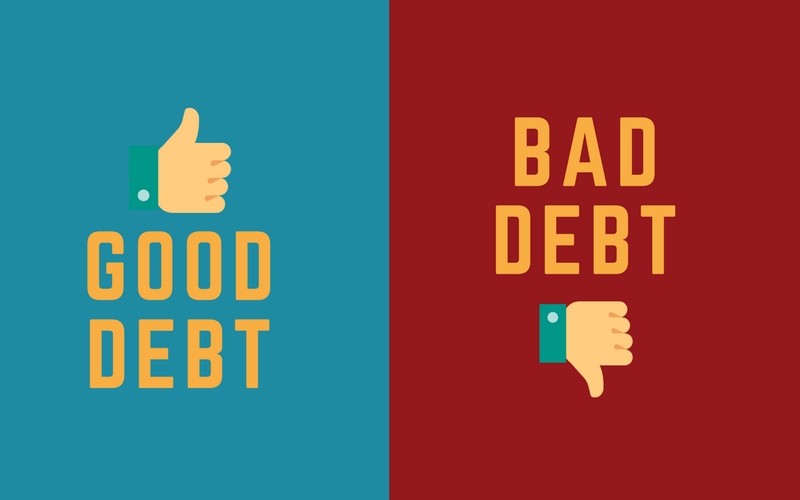What Are The Key Differences Between Good Debt And Bad Debt?
Debt or credit is one of the common financial products and services that I can divide into different categories. Debt can be of two different types: bad debt and good debt.
Good debt are investment projects that offer long-term profit potential to buyers. However, bad debt is used to cover mostly wasted assets for short-term consumption purposes.
The main difference between good debt and bad debt is whether it is profitable for the people who buy this debt or not. While individuals or businesses that borrow good debt invest the assets they borrow in long-term investment projects, bad debts are generally assets purchased for daily expenses or unnecessary consumption.
Bad debt is the debt processes that are taken unplanned by consumers with inadequate financial literacy and without a detailed preliminary study regarding the payment plan.
Good debt, on the other hand, is a type of debt in which the payment schedule is prepared in detail and these assets have profitable and profitable potential returns for the future of the borrowers.
How Do You Define Good Debt And Its Potential Benefits?

Good debt is a type of debt where a certain amount of assets are used in profitable investment projects with long-term perspectives. Thanks to Good Debt, people who borrow money generally increase their quality of life and financial stability by spending it for long-term goals rather than for daily consumption needs or unnecessary expenses.
The potential benefits of good debt examples for individuals who borrow are numerous. Taking out a loan for real estate opportunities such as buying a house or land is the most common example of good debt.
On the other hand, loans taken to meet educational needs are another common good debt practice. In such good debt examples, the assets borrowed offer the potential for a profitable, more educated, happier life and long-term income.
Good debt is borrowing for situations that arise from your real needs and are important for your future. I can remind you of some examples of good debts:
Owning a house by borrowing at affordable interest rates to meet your housing needs. You want to go abroad to study, but you do not have enough capital, so you can invest in your future by borrowing money.
Having a healthy body is our greatest wealth. Getting insurance for your health and getting into debt for it, Starting a business and expanding your business by borrowing money to practice your profession.
What Are The Characteristics Of Bad Debt And Its Risks To Financial Health?
Bad debt, of which we can see many examples especially in developing countries, is a type of debt that carries potential risks and losses for the borrower and has difficult repayment processes. The most common examples of this type of debt are high-interest loan packages, credit card debts where minimum payments and payment schedules are neglected.
In bad debt applications, repayment processes are often difficult for both the borrower and the lender. These are debts taken not for financial stability and financial goals, but for assets spent on personal and daily needs and business ideas with high risk factors.
People who take out this type of debt mostly turn to these types of debt for mandatory needs and to get rid of daily problems. However, investors who are more successful in terms of risk management show an example of profitable investment for their future by borrowing money to spend on areas such as real estate or education.
How Can You Distinguish Between Debt That Enhances Wealth And Debt That Doesn’t?

Debts are basically of two different types: those that increase/maintain their existence and value, and those that cannot increase their existence/decrease their value. While investment projects that manage to preserve the value of the asset generally provide financial growth, debt types that cannot preserve the value of the asset, which we can also call bad debt, are examples such as high-interest loan packages and credit card expenses with irregular repayments.
Debts that can maintain their value are generally purchased not only for short-term motivations but also for long-term perspectives. Debts purchased for motivations and needs such as education, health, enterprise and startups turn into profitable investment projects thanks to the returns on the areas where these assets are spent.
However, loans taken for a holiday or other needs expose the borrowers to some responsibilities after the purchase of that product or service. These responsibilities include a regular payment schedule, planning for repayment, etc. countable.
What Strategies Exist For Managing And Reducing Bad Debt?
Bad debts, which are purchased to meet daily needs, unnecessary expenses, and short-term purchases of products or services, are among the most common financial products today.
The potential risks and losses of bad debt are many for those who borrow this type of debt. Individuals or institutions forced to practice bad debt can benefit from some strategies to minimize losses and optimize financial stability.
Common strategies to transform the negative effects of bad debt for individuals into a more manageable form include budget planning, prioritizing debts, examining contractual terms regarding interest rates, creating alternative income sources, and receiving financial health education or counseling.
Circumstances may have forced you into bad debt conditions for your personal budget or the financial health of your business. In such cases, you can still minimize the negative effects of loans or debts that are harmful to your financial health by applying these tips.
Are There Cases Where Taking On Debt Can Lead To Positive Financial Outcomes?
Borrowing and taking out loans are not financial products that have negative consequences in any case. In some special cases, borrowing has many positive financial and social benefits.
It is known that the majority of today’s successful trade chains are indebted during their establishment and development processes. For this reason, we should remember that conscious borrowing, with a detailed repayment schedule, can offer positive financial results when considered together with its long-term returns.
For example, when an individual borrows a certain amount for his/her educational life and meets the essential needs such as books, transportation, and shelter during the education life, he/she shows a successful example of debt by receiving financial and social benefits after this education.
Real estate investment projects and various trade projects including e-commerce ones can be considered as common types of borrowings that offer different, positive financial results as an example of good debt practices.
See you in the next post,
Anil UZUN
